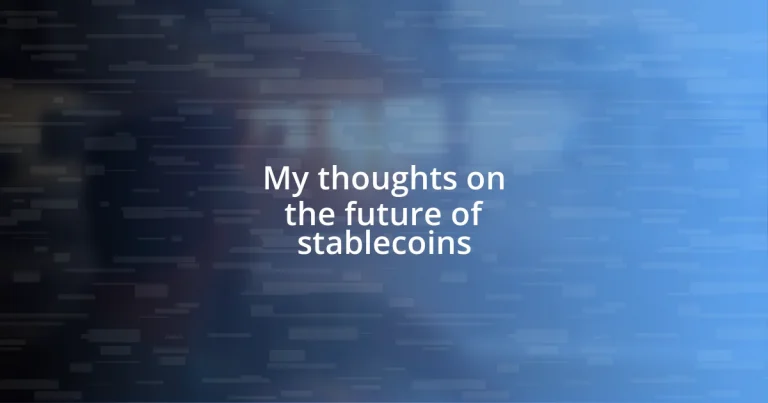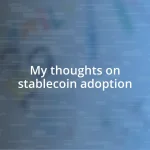Key takeaways:
- Stablecoins bridge traditional currencies and cryptocurrencies, offering a stable value amidst market volatility, facilitating cost-effective and instantaneous transactions.
- They provide benefits such as serving as inflation hedges, enabling seamless daily transactions, and reducing fees for international transfers.
- Challenges to adoption include regulatory uncertainty, security vulnerabilities, and liquidity issues, which impact user confidence and market growth.

Understanding stablecoins in finance
Stablecoins have emerged as a fascinating solution in the world of finance, acting as a bridge between traditional currency and the volatile realm of cryptocurrencies. Personally, I remember my first encounter with a stablecoin; it was like discovering a calm oasis in a desert of fluctuating prices. How incredible is it that a digital asset can hold its value with such stability while the market around it seems chaotic?
In essence, stablecoins are designed to be pegged to tangible assets, such as the US dollar or gold, making them more predictable. I often find myself pondering: wouldn’t it be great if our everyday transactions could feel just as reliable? This predictability not only boosts confidence among users but also opens doors for broader adoption in financial systems, which excites me for the future of digital payments.
The role of stablecoins goes beyond just providing a safeguard against volatility; they can also streamline transactions and reduce costs in traditional finance. I recall a time when sending money across borders meant significant fees and delays. With stablecoins, the idea of instant and cost-effective transfers fills me with hope. Can you imagine a world where sending money is as easy as sending a text? That’s the potential I see in stablecoins reshaping our financial interactions.

Benefits of stablecoins for users
Stablecoins offer tangible benefits that enhance the user experience in digital finance. For instance, the ease of making international transactions is tremendously appealing. I remember a situation where I needed to send money to a friend in a different country. The traditional methods were complex and costly, but using a stablecoin was both straightforward and economical. That moment really drove home how these digital assets can save us both time and money.
One of the remarkable advantages of stablecoins is their role as a hedge against inflation. I’ve often worried about the diminishing value of traditional currencies, especially in uncertain economic times. Holding stablecoins can provide a sense of security, as they are less susceptible to wild fluctuations. It’s like finding a safety net that allows you to maintain your savings without the constant fear of losing purchasing power.
Additionally, stablecoins can facilitate seamless everyday transactions. Imagine purchasing your morning coffee or groceries with a digital asset that maintains its value. Personally, I envision a future where I can pay for goods and services with stablecoins just as easily as I do with cash or credit. This level of flexibility not only simplifies financial life but also encourages more people to engage with cryptocurrency in a familiar way.
| Benefits of Stablecoins | Description |
|---|---|
| Cost-Effective Transactions | Reduce fees and time delays associated with cross-border payments. |
| Inflation Hedge | Provide a safeguard against the loss of purchasing power during economic instability. |
| Seamless Daily Use | Encourage everyday transactions with digital assets that retain consistent value. |

Challenges facing stablecoin adoption
Adopting stablecoins isn’t without its hurdles. I’ve noticed that regulations often create a bit of a roadblock. As I follow the evolving landscape of cryptocurrency regulations, it’s clear that many governments are still figuring out how to classify and control stablecoins. This uncertainty can make potential users hesitant to jump in, fearing they might land in legal hot water.
Moreover, the technology underpinning stablecoins presents its own set of challenges. Issues such as security vulnerabilities and system reliability can’t be overlooked. Here’s a quick breakdown of some key challenges:
-
Regulatory Uncertainty: Jurisdictions have varying stances on stablecoins, creating an unpredictable environment for users and issuers alike.
-
Security Concerns: The risk of hacks and fraud remains a concern, as we’ve seen with past incidents in the crypto world.
-
Liquidity Issues: Not all stablecoins enjoy equal liquidity, which can complicate trading and usage.
Each of these challenges can give users pause when considering stablecoins. I can empathize with those who might feel overwhelmed by the complexity of it all. Just as I was learning about stablecoins, I found myself questioning whether the potential benefits outweighed the risks. For me, recognizing these challenges is crucial to fostering a more informed conversation about the future of stablecoins.

Regulatory landscape for stablecoins
The regulatory landscape for stablecoins is a mixed bag of hope and hesitation. As I’ve delved into this topic, it’s clear that governments worldwide are at different stages of crafting regulations. For instance, while some jurisdictions are developing frameworks that promote innovation and protect consumers, others are imposing strict limitations that could stifle growth. It’s fascinating, but also disheartening, to see how these varying approaches can create confusion for developers and users alike.
I recall a moment when I attended a conference about the future of digital finance, where the discussion on stablecoin regulations sparked a lively debate. Some panelists expressed optimism, pointing out how regulations could legitimize stablecoins, providing a safety net for users. Others worried about potential overreach, fearing that excessive regulation might push innovation underground. It made me wonder: how do we strike that delicate balance between security and innovation?
Reflecting on my experiences, I realize that clear and consistent regulations could pave the way for broader acceptance of stablecoins. Imagine using a stablecoin in your everyday transactions without the fear of regulatory pitfalls! That possibility excites me, and I genuinely hope to see a future where these digital assets can coexist harmoniously with regulatory frameworks, enhancing user trust and participation in the global economy.

Future trends in stablecoin technology
As I explore future trends in stablecoin technology, I can’t help but feel a wave of excitement about the potential for innovation. One trend that stands out to me is the increasing use of decentralized finance (DeFi) frameworks to enhance transparency and security. Imagine a world where stablecoins operate within decentralized protocols, making transactions not just faster but also more secure. Have you ever wondered how such a shift could reshuffle the whole financial landscape? I believe it could empower users and provide a robust alternative to traditional banking systems.
Another significant trend is the emergence of algorithmic stablecoins, which manage their supply dynamically to maintain value stability. I’ve witnessed debates around their effectiveness, yet I find the concept intriguing. If these stablecoins can achieve true stability without collateral backing, it could revolutionize the way we think about currency. Just think about it: a stable asset that adjusts in real-time based on market demand. How cool would that be? From my perspective, the key will be developing algorithms that respond intelligently to market fluctuations without creating new vulnerabilities.
Finally, we can’t overlook the integration of stablecoins into everyday transactions. I remember my last trip abroad, where I struggled with currency conversion fees and delays at exchange kiosks. If stablecoins become more widely accepted by merchants and platforms globally, we could simplify international trade and travel immensely. Wouldn’t it be awesome to use a stablecoin to make purchases across borders instantly and at a lower cost? I genuinely believe we’re on the brink of a major evolution in how we use money, and stablecoins could lead the way toward a more seamless, interconnected financial future.














